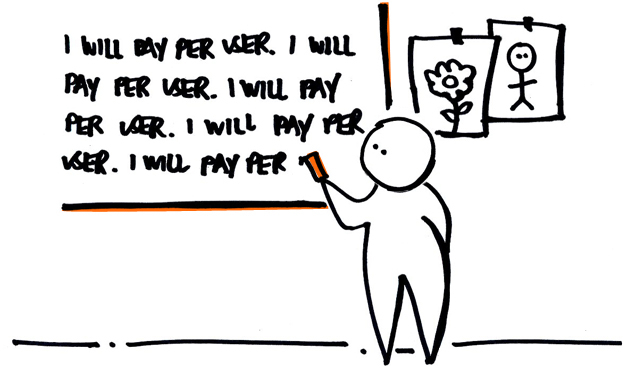
Over the years, we have seen many businesses adopt a per-project or per-user pricing structure, which pushes customers to re-evaluate the value of the products they are using. Not only does this run the risk of losing customers, but it goes as far as punishing them for their loyalty. Why would any company chose to lose customers? More than that, why would they punish them for using their products?
Take for example, GitHub. We love their service. We use their private project repository. But then we hit our limit and it had us think twice about the service because we would've had to pay for more space. Instead, we just deleted older projects to make room.
The problem with volume-pricing is that it's stressful. It leaves the customer wondering what they'll have to pay in the future, and often punishes usage. Many companies use a volume-discount approach. As companies scale, they are forced to pay more for the apps they already use even though they end up paying less per user. This puts customers in a bind, forcing them to choose who receives access to the tools or what projects to use the tools for. Only giving 10% of your company access to a tool rather than 50% to 100% will negatively affect the value of using the tool.
Customers shouldn't need to think about pricing.
Take Netflix. How many of us have a "watch instantly" account, which withdraws about $8 bucks a month from our bank accounts? And that's if we use the service or not. We don't even have to think about it. We aren't allotted a set amount of hours we are allowed to watch programing without paying more.
But what if we were? If after watching 10 hours of television you were required to pay more, you might have to think twice about subscribing to the service entirely.
Charging For Features, Not Users
Recently, we re-launched Verify with not only new features, but a new pricing structure. Though we never charged on a per-user basis, we added value for all of our users with mobile testing. We also created a new tier of service with a new < a href="https://zurb.com/apps/842-verify-introducing-multivariate-and-multi-">premium feature.
We understood, that depending on the size of our customers' companies, this feature may not be the perfect fit so the new tier and premium pricing is an option, not a requirement. However, we also realize that regardless of a company's specific product needs their operational needs will vary as they gain and lose staff and clients. Why inconvenience your customers because of uncontrollable variables instead of a change in product need?
With Notable, we determine value based on the features a company needed to effectively collect and organize the feedback they need for their designs. We often find that larger companies with several users and multiple simultaneous projects may find use for the freedom to organize within sets and workspaces available on our upper tiered plans. While freelancers or small businesses might not have a need for these organizational features, but still may have a variable amount of hands in the bucket.
Think of it this way. What is the use of product design applications if you are limited by the amount of feedback you can receive? Why would we charge people to involve more influencers from their own business or client list? It just doesn't make any sense and causes unnecessary stress for growing companies unable to predict the expense of using these products.
Per-user pricing simply does not put the customer first. That's because they'll constantly need to reevaluate the your product's benefits each time the price goes up. This will drastically affect the adoption of your product. Let your users have flexibility and decide what features are best for them instead of who is best to use these features. Don't let your customers outgrow your product, instead allow your product to grow and become an integral part of their daily workflow.
What are your thoughts on per-user pricing? Does it work for you or would you prefer a simply subscription that is flexible to your needs? Let us know in the comments below.